Criminology Report: Challenges in Criminology and Criminal Justice
VerifiedAdded on 2021/05/31
|5
|1335
|200
Report
AI Summary
This criminology report delves into the challenges faced by modern crime theories, examining their basic premises and the factors influencing criminal behavior. It explores the evolution of criminology, including the role of crime statistics, the development of crime reduction strategies, and the influence of government policies. The report analyzes legal responses to crime, highlighting the importance of intent in allocating guilt and the existing barriers in the conviction process. It also discusses various approaches to crime control, such as new penology, and the evaluation of programs like intensive supervision and boot camps. The report further examines the issues of prison violence, rehabilitation, and the social construction of crime, emphasizing the need for improved criminal justice systems. Finally, the report concludes by emphasizing the importance of continuous improvement in the criminal justice system through the application of effective policies and programs.
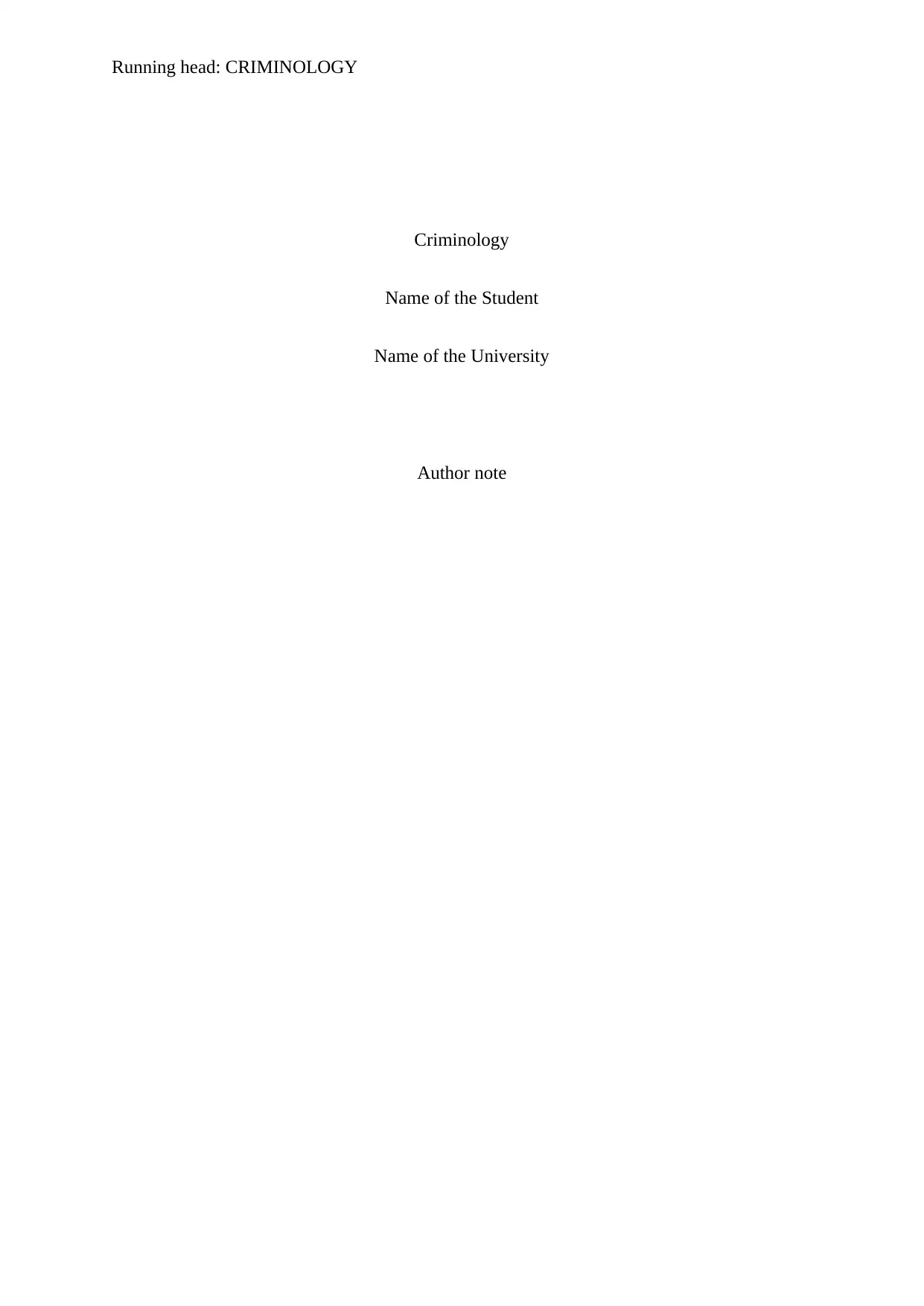
Running head: CRIMINOLOGY
Criminology
Name of the Student
Name of the University
Author note
Criminology
Name of the Student
Name of the University
Author note
Paraphrase This Document
Need a fresh take? Get an instant paraphrase of this document with our AI Paraphraser
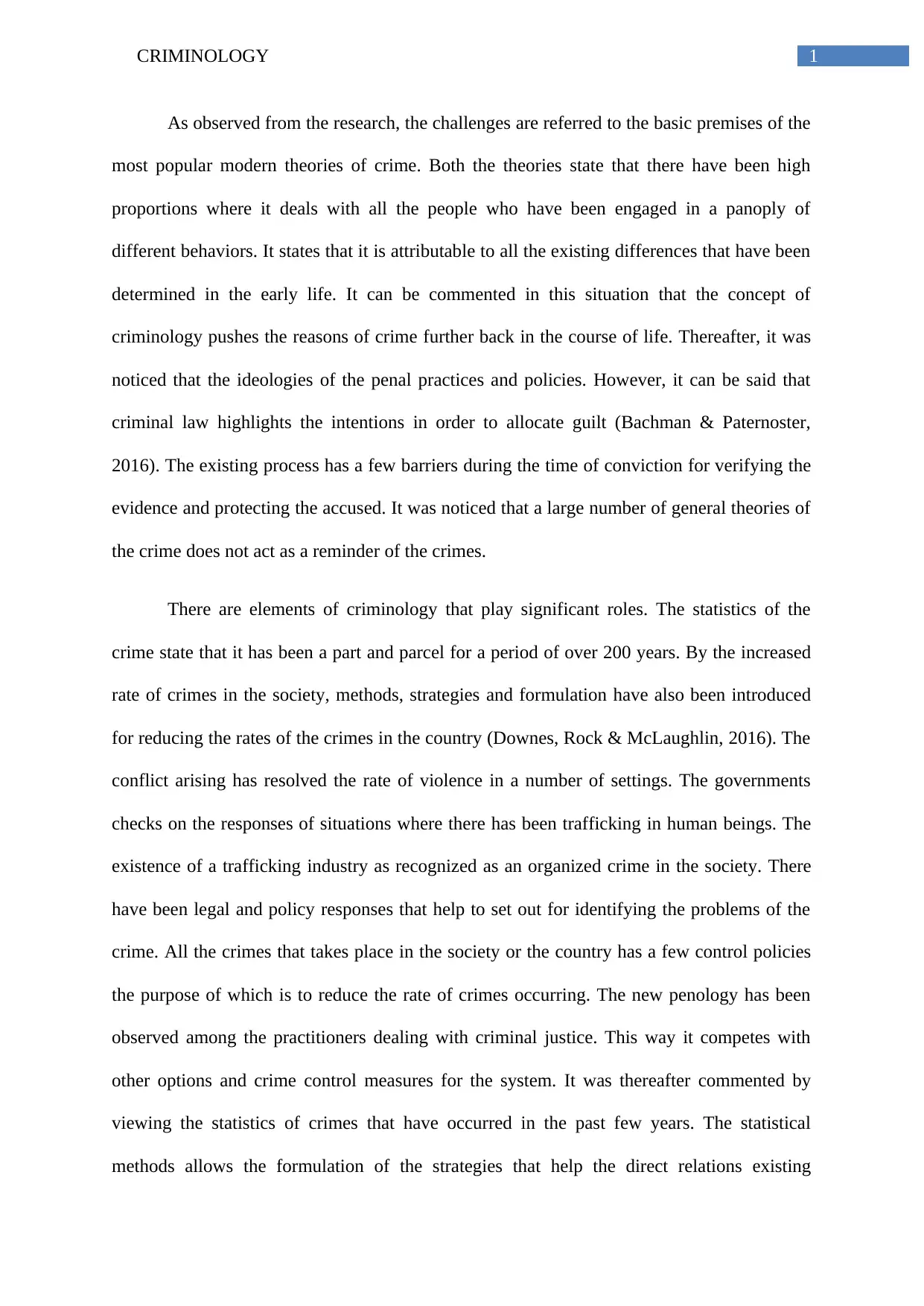
1CRIMINOLOGY
As observed from the research, the challenges are referred to the basic premises of the
most popular modern theories of crime. Both the theories state that there have been high
proportions where it deals with all the people who have been engaged in a panoply of
different behaviors. It states that it is attributable to all the existing differences that have been
determined in the early life. It can be commented in this situation that the concept of
criminology pushes the reasons of crime further back in the course of life. Thereafter, it was
noticed that the ideologies of the penal practices and policies. However, it can be said that
criminal law highlights the intentions in order to allocate guilt (Bachman & Paternoster,
2016). The existing process has a few barriers during the time of conviction for verifying the
evidence and protecting the accused. It was noticed that a large number of general theories of
the crime does not act as a reminder of the crimes.
There are elements of criminology that play significant roles. The statistics of the
crime state that it has been a part and parcel for a period of over 200 years. By the increased
rate of crimes in the society, methods, strategies and formulation have also been introduced
for reducing the rates of the crimes in the country (Downes, Rock & McLaughlin, 2016). The
conflict arising has resolved the rate of violence in a number of settings. The governments
checks on the responses of situations where there has been trafficking in human beings. The
existence of a trafficking industry as recognized as an organized crime in the society. There
have been legal and policy responses that help to set out for identifying the problems of the
crime. All the crimes that takes place in the society or the country has a few control policies
the purpose of which is to reduce the rate of crimes occurring. The new penology has been
observed among the practitioners dealing with criminal justice. This way it competes with
other options and crime control measures for the system. It was thereafter commented by
viewing the statistics of crimes that have occurred in the past few years. The statistical
methods allows the formulation of the strategies that help the direct relations existing
As observed from the research, the challenges are referred to the basic premises of the
most popular modern theories of crime. Both the theories state that there have been high
proportions where it deals with all the people who have been engaged in a panoply of
different behaviors. It states that it is attributable to all the existing differences that have been
determined in the early life. It can be commented in this situation that the concept of
criminology pushes the reasons of crime further back in the course of life. Thereafter, it was
noticed that the ideologies of the penal practices and policies. However, it can be said that
criminal law highlights the intentions in order to allocate guilt (Bachman & Paternoster,
2016). The existing process has a few barriers during the time of conviction for verifying the
evidence and protecting the accused. It was noticed that a large number of general theories of
the crime does not act as a reminder of the crimes.
There are elements of criminology that play significant roles. The statistics of the
crime state that it has been a part and parcel for a period of over 200 years. By the increased
rate of crimes in the society, methods, strategies and formulation have also been introduced
for reducing the rates of the crimes in the country (Downes, Rock & McLaughlin, 2016). The
conflict arising has resolved the rate of violence in a number of settings. The governments
checks on the responses of situations where there has been trafficking in human beings. The
existence of a trafficking industry as recognized as an organized crime in the society. There
have been legal and policy responses that help to set out for identifying the problems of the
crime. All the crimes that takes place in the society or the country has a few control policies
the purpose of which is to reduce the rate of crimes occurring. The new penology has been
observed among the practitioners dealing with criminal justice. This way it competes with
other options and crime control measures for the system. It was thereafter commented by
viewing the statistics of crimes that have occurred in the past few years. The statistical
methods allows the formulation of the strategies that help the direct relations existing
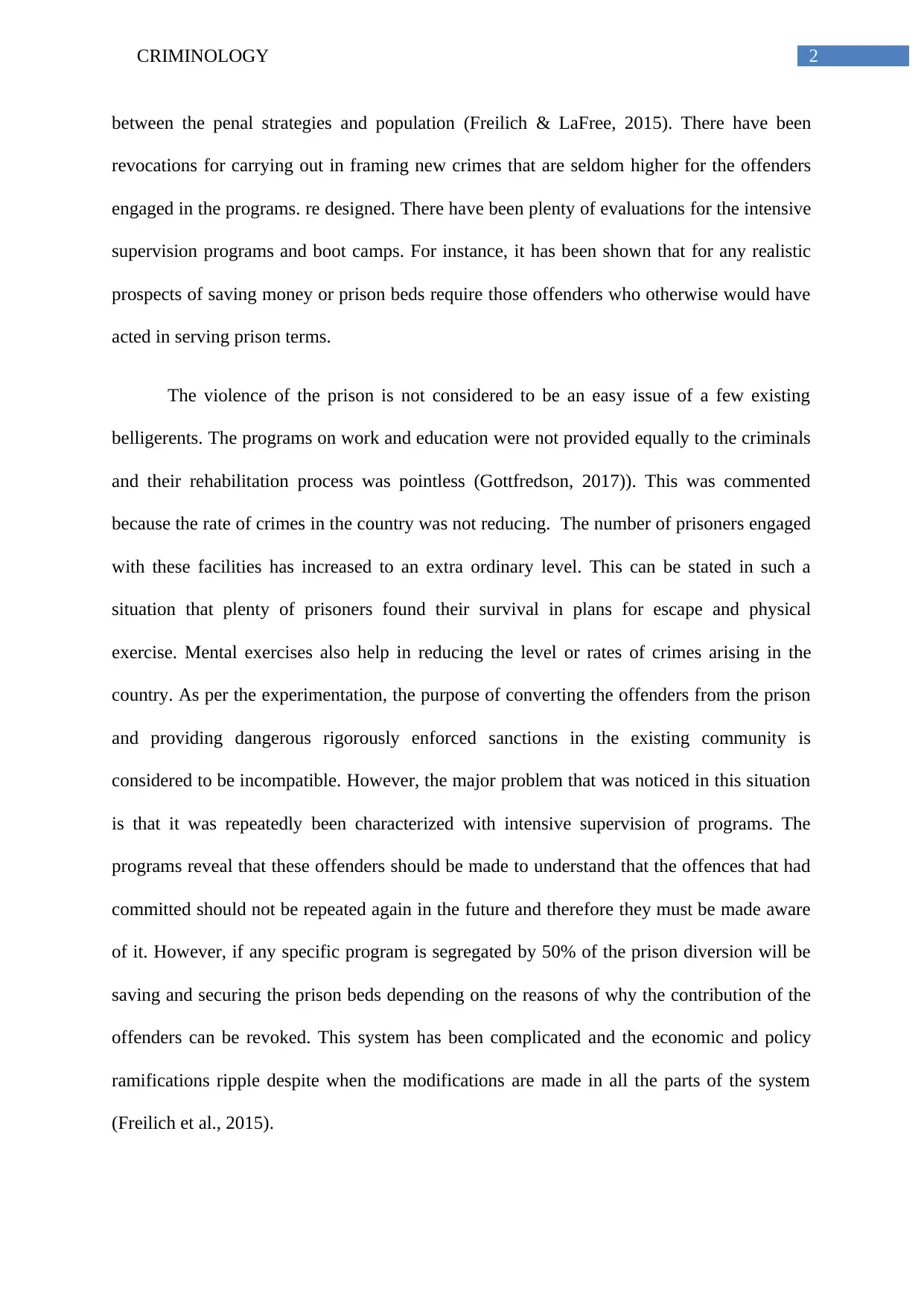
2CRIMINOLOGY
between the penal strategies and population (Freilich & LaFree, 2015). There have been
revocations for carrying out in framing new crimes that are seldom higher for the offenders
engaged in the programs. re designed. There have been plenty of evaluations for the intensive
supervision programs and boot camps. For instance, it has been shown that for any realistic
prospects of saving money or prison beds require those offenders who otherwise would have
acted in serving prison terms.
The violence of the prison is not considered to be an easy issue of a few existing
belligerents. The programs on work and education were not provided equally to the criminals
and their rehabilitation process was pointless (Gottfredson, 2017)). This was commented
because the rate of crimes in the country was not reducing. The number of prisoners engaged
with these facilities has increased to an extra ordinary level. This can be stated in such a
situation that plenty of prisoners found their survival in plans for escape and physical
exercise. Mental exercises also help in reducing the level or rates of crimes arising in the
country. As per the experimentation, the purpose of converting the offenders from the prison
and providing dangerous rigorously enforced sanctions in the existing community is
considered to be incompatible. However, the major problem that was noticed in this situation
is that it was repeatedly been characterized with intensive supervision of programs. The
programs reveal that these offenders should be made to understand that the offences that had
committed should not be repeated again in the future and therefore they must be made aware
of it. However, if any specific program is segregated by 50% of the prison diversion will be
saving and securing the prison beds depending on the reasons of why the contribution of the
offenders can be revoked. This system has been complicated and the economic and policy
ramifications ripple despite when the modifications are made in all the parts of the system
(Freilich et al., 2015).
between the penal strategies and population (Freilich & LaFree, 2015). There have been
revocations for carrying out in framing new crimes that are seldom higher for the offenders
engaged in the programs. re designed. There have been plenty of evaluations for the intensive
supervision programs and boot camps. For instance, it has been shown that for any realistic
prospects of saving money or prison beds require those offenders who otherwise would have
acted in serving prison terms.
The violence of the prison is not considered to be an easy issue of a few existing
belligerents. The programs on work and education were not provided equally to the criminals
and their rehabilitation process was pointless (Gottfredson, 2017)). This was commented
because the rate of crimes in the country was not reducing. The number of prisoners engaged
with these facilities has increased to an extra ordinary level. This can be stated in such a
situation that plenty of prisoners found their survival in plans for escape and physical
exercise. Mental exercises also help in reducing the level or rates of crimes arising in the
country. As per the experimentation, the purpose of converting the offenders from the prison
and providing dangerous rigorously enforced sanctions in the existing community is
considered to be incompatible. However, the major problem that was noticed in this situation
is that it was repeatedly been characterized with intensive supervision of programs. The
programs reveal that these offenders should be made to understand that the offences that had
committed should not be repeated again in the future and therefore they must be made aware
of it. However, if any specific program is segregated by 50% of the prison diversion will be
saving and securing the prison beds depending on the reasons of why the contribution of the
offenders can be revoked. This system has been complicated and the economic and policy
ramifications ripple despite when the modifications are made in all the parts of the system
(Freilich et al., 2015).
⊘ This is a preview!⊘
Do you want full access?
Subscribe today to unlock all pages.

Trusted by 1+ million students worldwide
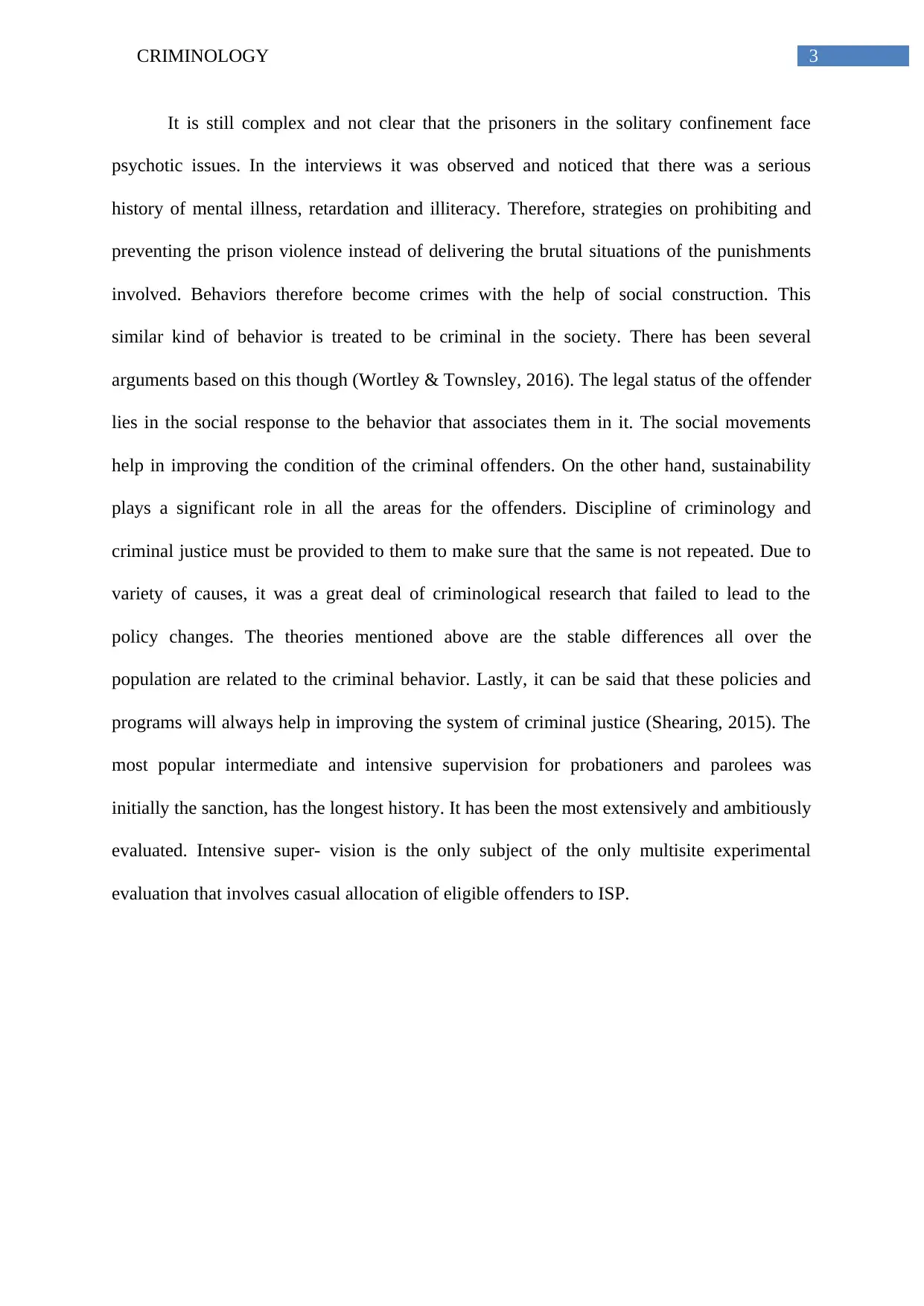
3CRIMINOLOGY
It is still complex and not clear that the prisoners in the solitary confinement face
psychotic issues. In the interviews it was observed and noticed that there was a serious
history of mental illness, retardation and illiteracy. Therefore, strategies on prohibiting and
preventing the prison violence instead of delivering the brutal situations of the punishments
involved. Behaviors therefore become crimes with the help of social construction. This
similar kind of behavior is treated to be criminal in the society. There has been several
arguments based on this though (Wortley & Townsley, 2016). The legal status of the offender
lies in the social response to the behavior that associates them in it. The social movements
help in improving the condition of the criminal offenders. On the other hand, sustainability
plays a significant role in all the areas for the offenders. Discipline of criminology and
criminal justice must be provided to them to make sure that the same is not repeated. Due to
variety of causes, it was a great deal of criminological research that failed to lead to the
policy changes. The theories mentioned above are the stable differences all over the
population are related to the criminal behavior. Lastly, it can be said that these policies and
programs will always help in improving the system of criminal justice (Shearing, 2015). The
most popular intermediate and intensive supervision for probationers and parolees was
initially the sanction, has the longest history. It has been the most extensively and ambitiously
evaluated. Intensive super- vision is the only subject of the only multisite experimental
evaluation that involves casual allocation of eligible offenders to ISP.
It is still complex and not clear that the prisoners in the solitary confinement face
psychotic issues. In the interviews it was observed and noticed that there was a serious
history of mental illness, retardation and illiteracy. Therefore, strategies on prohibiting and
preventing the prison violence instead of delivering the brutal situations of the punishments
involved. Behaviors therefore become crimes with the help of social construction. This
similar kind of behavior is treated to be criminal in the society. There has been several
arguments based on this though (Wortley & Townsley, 2016). The legal status of the offender
lies in the social response to the behavior that associates them in it. The social movements
help in improving the condition of the criminal offenders. On the other hand, sustainability
plays a significant role in all the areas for the offenders. Discipline of criminology and
criminal justice must be provided to them to make sure that the same is not repeated. Due to
variety of causes, it was a great deal of criminological research that failed to lead to the
policy changes. The theories mentioned above are the stable differences all over the
population are related to the criminal behavior. Lastly, it can be said that these policies and
programs will always help in improving the system of criminal justice (Shearing, 2015). The
most popular intermediate and intensive supervision for probationers and parolees was
initially the sanction, has the longest history. It has been the most extensively and ambitiously
evaluated. Intensive super- vision is the only subject of the only multisite experimental
evaluation that involves casual allocation of eligible offenders to ISP.
Paraphrase This Document
Need a fresh take? Get an instant paraphrase of this document with our AI Paraphraser
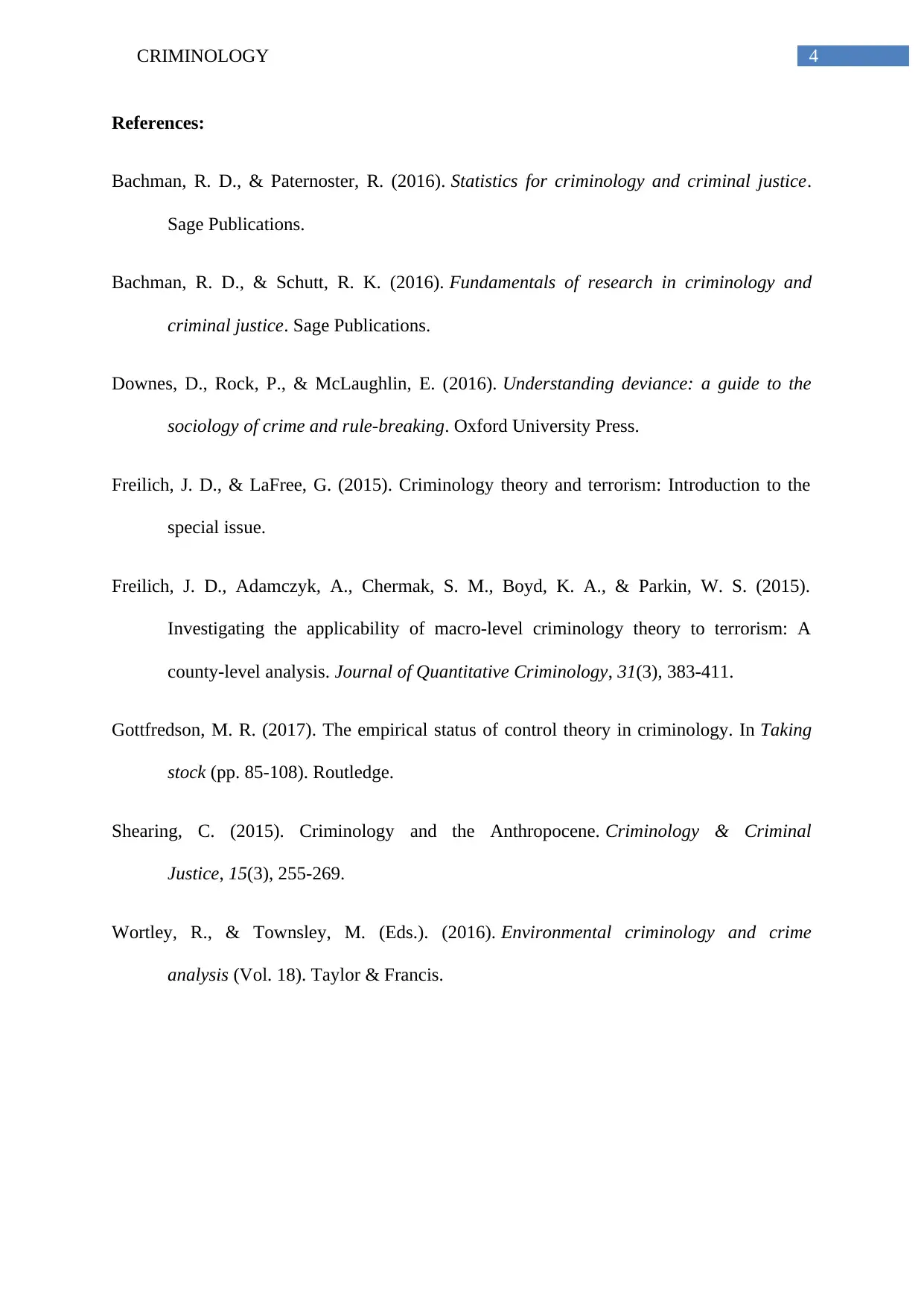
4CRIMINOLOGY
References:
Bachman, R. D., & Paternoster, R. (2016). Statistics for criminology and criminal justice.
Sage Publications.
Bachman, R. D., & Schutt, R. K. (2016). Fundamentals of research in criminology and
criminal justice. Sage Publications.
Downes, D., Rock, P., & McLaughlin, E. (2016). Understanding deviance: a guide to the
sociology of crime and rule-breaking. Oxford University Press.
Freilich, J. D., & LaFree, G. (2015). Criminology theory and terrorism: Introduction to the
special issue.
Freilich, J. D., Adamczyk, A., Chermak, S. M., Boyd, K. A., & Parkin, W. S. (2015).
Investigating the applicability of macro-level criminology theory to terrorism: A
county-level analysis. Journal of Quantitative Criminology, 31(3), 383-411.
Gottfredson, M. R. (2017). The empirical status of control theory in criminology. In Taking
stock (pp. 85-108). Routledge.
Shearing, C. (2015). Criminology and the Anthropocene. Criminology & Criminal
Justice, 15(3), 255-269.
Wortley, R., & Townsley, M. (Eds.). (2016). Environmental criminology and crime
analysis (Vol. 18). Taylor & Francis.
References:
Bachman, R. D., & Paternoster, R. (2016). Statistics for criminology and criminal justice.
Sage Publications.
Bachman, R. D., & Schutt, R. K. (2016). Fundamentals of research in criminology and
criminal justice. Sage Publications.
Downes, D., Rock, P., & McLaughlin, E. (2016). Understanding deviance: a guide to the
sociology of crime and rule-breaking. Oxford University Press.
Freilich, J. D., & LaFree, G. (2015). Criminology theory and terrorism: Introduction to the
special issue.
Freilich, J. D., Adamczyk, A., Chermak, S. M., Boyd, K. A., & Parkin, W. S. (2015).
Investigating the applicability of macro-level criminology theory to terrorism: A
county-level analysis. Journal of Quantitative Criminology, 31(3), 383-411.
Gottfredson, M. R. (2017). The empirical status of control theory in criminology. In Taking
stock (pp. 85-108). Routledge.
Shearing, C. (2015). Criminology and the Anthropocene. Criminology & Criminal
Justice, 15(3), 255-269.
Wortley, R., & Townsley, M. (Eds.). (2016). Environmental criminology and crime
analysis (Vol. 18). Taylor & Francis.
1 out of 5
Related Documents
Your All-in-One AI-Powered Toolkit for Academic Success.
+13062052269
info@desklib.com
Available 24*7 on WhatsApp / Email
![[object Object]](/_next/static/media/star-bottom.7253800d.svg)
Unlock your academic potential
Copyright © 2020–2025 A2Z Services. All Rights Reserved. Developed and managed by ZUCOL.




